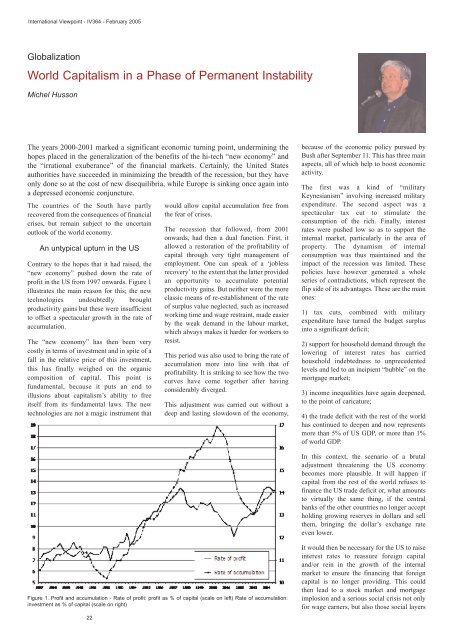IV 364 - International Viewpoint
IV 364 - International Viewpoint
IV 364 - International Viewpoint
Create successful ePaper yourself
Turn your PDF publications into a flip-book with our unique Google optimized e-Paper software.
<strong>International</strong> <strong>Viewpoint</strong> - <strong>IV</strong><strong>364</strong> - February 2005<br />
Globalization<br />
World Capitalism in a Phase of Permanent Instability<br />
Michel Husson<br />
The years 2000-2001 marked a significant economic turning point, undermining the<br />
hopes placed in the generalization of the benefits of the hi-tech “new economy” and<br />
the “irrational exuberance” of the financial markets. Certainly, the United States<br />
authorities have succeeded in minimizing the breadth of the recession, but they have<br />
only done so at the cost of new disequilibria, while Europe is sinking once again into<br />
a depressed economic conjuncture.<br />
The countries of the South have partly<br />
recovered from the consequences of financial<br />
crises, but remain subject to the uncertain<br />
outlook of the world economy.<br />
An untypical upturn in the US<br />
Contrary to the hopes that it had raised, the<br />
“new economy” pushed down the rate of<br />
profit in the US from 1997 onwards. Figure 1<br />
illustrates the main reason for this; the new<br />
technologies undoubtedly brought<br />
productivity gains but these were insufficient<br />
to offset a spectacular growth in the rate of<br />
accumulation.<br />
The “new economy” has then been very<br />
costly in terms of investment and in spite of a<br />
fall in the relative price of this investment,<br />
this has finally weighed on the organic<br />
composition of capital. This point is<br />
fundamental, because it puts an end to<br />
illusions about capitalism’s ability to free<br />
itself from its fundamental laws. The new<br />
technologies are not a magic instrument that<br />
22<br />
would allow capital accumulation free from<br />
the fear of crises.<br />
The recession that followed, from 2001<br />
onwards, had then a dual function. First, it<br />
allowed a restoration of the profitability of<br />
capital through very tight management of<br />
employment. One can speak of a ‘jobless<br />
recovery’ to the extent that the latter provided<br />
an opportunity to accumulate potential<br />
productivity gains. But neither were the more<br />
classic means of re-establishment of the rate<br />
of surplus value neglected, such as increased<br />
working time and wage restraint, made easier<br />
by the weak demand in the labour market,<br />
which always makes it harder for workers to<br />
resist.<br />
This period was also used to bring the rate of<br />
accumulation more into line with that of<br />
profitability. It is striking to see how the two<br />
curves have come together after having<br />
considerably diverged.<br />
This adjustment was carried out without a<br />
deep and lasting slowdown of the economy,<br />
Figure 1. Profit and accumulation - Rate of profit: profit as % of capital (scale on left) Rate of accumulation:<br />
investment as % of capital (scale on right)<br />
because of the economic policy pursued by<br />
Bush after September 11. This has three main<br />
aspects, all of which help to boost economic<br />
activity.<br />
The first was a kind of “military<br />
Keynesianism” involving increased military<br />
expenditure. The second aspect was a<br />
spectacular tax cut to stimulate the<br />
consumption of the rich. Finally, interest<br />
rates were pushed low so as to support the<br />
internal market, particularly in the area of<br />
property. The dynamism of internal<br />
consumption was thus maintained and the<br />
impact of the recession was limited. These<br />
policies have however generated a whole<br />
series of contradictions, which represent the<br />
flip side of its advantages. These are the main<br />
ones:<br />
1) tax cuts, combined with military<br />
expenditure have turned the budget surplus<br />
into a significant deficit;<br />
2) support for household demand through the<br />
lowering of interest rates has carried<br />
household indebtedness to unprecedented<br />
levels and led to an incipient “bubble” on the<br />
mortgage market;<br />
3) income inequalities have again deepened,<br />
to the point of caricature;<br />
4) the trade deficit with the rest of the world<br />
has continued to deepen and now represents<br />
more than 5% of US GDP, or more than 1%<br />
of world GDP.<br />
In this context, the scenario of a brutal<br />
adjustment threatening the US economy<br />
becomes more plausible. It will happen if<br />
capital from the rest of the world refuses to<br />
finance the US trade deficit or, what amounts<br />
to virtually the same thing, if the central<br />
banks of the other countries no longer accept<br />
holding growing reserves in dollars and sell<br />
them, bringing the dollar’s exchange rate<br />
even lower.<br />
It would then be necessary for the US to raise<br />
interest rates to reassure foreign capital<br />
and/or rein in the growth of the internal<br />
market to ensure the financing that foreign<br />
capital is no longer providing. This could<br />
then lead to a stock market and mortgage<br />
implosion and a serious social crisis not only<br />
for wage earners, but also those social layers









